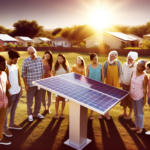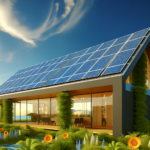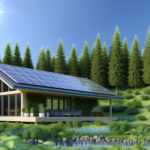Introduction to Solar Resilience
Understanding Solar Resilience
Solar resilience refers to the capacity of solar energy systems to withstand, adapt to, and quickly recover from natural disasters. It encompasses the robustness of solar infrastructure, the ability to maintain energy production during disruptions, and the flexibility to support recovery efforts. As the frequency and severity of natural disasters increase, solar resilience has become a critical component of sustainable disaster management strategies.
The Importance of Sustainable Energy During Disasters
During natural disasters, traditional power grids are often compromised, leading to widespread outages that can hamper rescue and recovery operations. Sustainable energy sources, particularly solar power, play a vital role in providing reliable and uninterrupted energy supply in such scenarios. Solar energy, being decentralized and renewable, offers a secure alternative to conventional power sources, ensuring that critical services remain operational.
Overview of Solar Technologies
Solar technologies harness the sun’s energy and convert it into usable electricity or thermal energy. The most common solar technologies include photovoltaic (PV) systems, which convert sunlight directly into electricity, and concentrated solar power (CSP), which uses mirrors to concentrate sunlight to drive traditional steam turbines or engines that create electricity. Advancements in solar technology have led to more efficient and resilient solar panels, energy storage systems, and smart grid integrations, enhancing their suitability for disaster-prone areas.
The Role of Solar Power in Emergency Preparedness
Solar power is increasingly recognized as a key component of emergency preparedness plans. It provides a reliable source of power for critical infrastructure such as hospitals, emergency shelters, and communication systems. Portable solar generators and solar-powered microgrids can be rapidly deployed to affected areas, offering immediate relief and supporting longer-term recovery efforts. By integrating solar power into emergency preparedness, communities can build a sustainable safety net that mitigates the impact of natural disasters.
The Impact of Natural Disasters on Energy Infrastructure
Vulnerability of Traditional Power Grids
The traditional power grid, a complex network of power generation, transmission, and distribution, is highly susceptible to the impacts of natural disasters. Centralized power plants and extensive transmission lines create a fragile web that, when disrupted, can lead to widespread power outages. The vulnerability of this infrastructure is multifaceted, involving physical damage to components, system overload due to sudden changes in demand, and the inherent limitations of a centralized system in quickly adapting to crisis conditions. The reliance on fossil fuels further exacerbates the grid’s fragility, as fuel supply lines are also prone to disruption during disasters.
Case Studies: Energy Failures During Disasters
Historical events have highlighted the fragility of energy infrastructure in the face of natural calamities. For instance, Hurricane Sandy in 2012 left millions without power across multiple states, revealing the vulnerability of overhead lines and substations to flooding and wind damage. Similarly, the 2017 Hurricane Maria’s devastation of Puerto Rico’s power grid resulted in the longest blackout in US history, with tragic consequences for healthcare and other critical services. California’s wildfires have repeatedly damaged transmission lines, leading to preventive power shutoffs that impact millions. These case studies underscore the need for more resilient energy systems that can withstand and quickly recover from such events.
The Need for Decentralized Energy Solutions
Decentralized energy solutions, such as microgrids and distributed generation, offer a pathway to enhance the resilience of our energy infrastructure. By localizing energy production, these systems can maintain power independently of the central grid, ensuring continuous electricity supply to critical facilities and reducing the cascade of failures that can occur with centralized systems. Solar power, with its ability to be deployed at various scales and its lack of reliance on fuel supply chains, is particularly well-suited for such decentralized approaches. Integrating solar with energy storage and smart grid technologies can create self-sufficient systems that are less vulnerable to natural disasters and capable of a more rapid recovery.
In conclusion, the traditional power grid’s susceptibility to natural disasters necessitates a shift towards more resilient, decentralized energy solutions. Solar power, with its inherent advantages, stands at the forefront of this transformation, offering a sustainable and reliable alternative that can help mitigate the risks associated with our current energy infrastructure.
Solar Power as a Safety Net
Advantages of Solar Energy in Disaster Scenarios
In the wake of increasing natural disasters, solar energy emerges as a beacon of resilience, offering numerous advantages. Solar power systems provide reliable and renewable energy that is not dependent on fuel supply chains, which are often disrupted during disasters. With the ability to generate electricity from sunlight, solar panels ensure a consistent energy source when traditional power grids fail. Moreover, solar installations with battery storage can instantly switch to off-grid mode, maintaining power for critical needs such as medical devices, refrigeration, and communication systems.
Portable and Off-Grid Solar Solutions
Portable solar generators and off-grid solar solutions are vital in disaster-stricken areas where the power infrastructure is compromised. These systems are easy to deploy and can be used to power individual homes or serve as community charging stations. Off-grid solar solutions are particularly beneficial in remote locations, providing independent power generation without the need for a centralized grid, thus enhancing the community’s self-sufficiency and resilience.
Solar Power for Critical Infrastructure
Critical infrastructure such as hospitals, emergency response centers, and shelters can greatly benefit from solar power. By equipping these facilities with solar panels and energy storage, they can continue to operate during grid outages, ensuring uninterrupted service to those in need. Solar power can also support communication networks, which are crucial for coordinating rescue and relief efforts.
Community Solar Projects and Disaster Relief
Community solar projects play a pivotal role in disaster relief by providing shared resources that can support entire neighborhoods. These projects not only offer emergency power but also foster a sense of community and shared responsibility. In the aftermath of a disaster, community solar can facilitate the rapid restoration of power, aiding in the recovery process and providing a sustainable safety net for affected populations.
In conclusion, solar power stands out as a robust safety net in the face of natural disasters. Its ability to provide decentralized, sustainable, and reliable energy ensures that communities can remain resilient and recover more quickly when faced with power disruptions. As we continue to witness the escalating impact of climate change, the integration of solar power into our energy infrastructure is not just beneficial—it’s imperative for a sustainable and secure future.
Building a Solar-Resilient System
Components of a Solar-Resilient System
A solar-resilient system is composed of several key components that work together to ensure continuous power supply during and after natural disasters. The primary elements include high-efficiency solar panels that capture sunlight and convert it into electricity, inverters that transform the direct current (DC) from the panels into alternating current (AC) for home use, and energy storage solutions such as batteries that store excess energy for later use. Additionally, smart grid technologies are integrated to manage energy flow and maintain system stability, while microgrids can operate independently from the main grid to provide localized energy distribution.
Integrating Solar with Other Renewable Sources
For enhanced reliability and resilience, solar power systems are often integrated with other renewable energy sources like wind or hydroelectric power. This diversification creates a more robust energy mix that can compensate for the variability of solar energy due to weather conditions. Hybrid systems that combine multiple sources of renewable energy can provide a steadier and more reliable power supply, ensuring that critical infrastructure remains operational during disasters.
Energy Storage Solutions
Energy storage is a vital component of a solar-resilient system. It allows for the accumulation of surplus solar energy during peak production times, which can then be used during periods of low sunlight or grid outages. Advanced battery technologies, such as lithium-ion and flow batteries, offer high energy density and long cycle life, making them suitable for solar applications. Moreover, energy management systems (EMS) are crucial for optimizing the use and distribution of stored energy, ensuring that critical loads are always powered.
Designing for Durability and Reliability
Designing a solar-resilient system requires careful consideration of durability and reliability. Solar panels and components must be weather-resistant and capable of withstanding harsh environmental conditions. Redundant systems and fail-safes are incorporated to maintain functionality even if one part of the system fails. Additionally, remote monitoring and diagnostic tools enable proactive maintenance and quick response to any issues, further enhancing the system’s resilience.
Case Studies: Success Stories of Solar Resilience
Residential Solar Success During Disasters
In the face of natural disasters, residential solar systems have proven to be a reliable source of power when traditional grids fail. For instance, during Hurricane Sandy in 2012, homes with solar panels in New Jersey and New York were some of the few that maintained electricity. This resilience is attributed to solar’s decentralized nature, allowing homeowners to generate power independently. Moreover, the integration of battery storage systems has enabled households to store excess energy, ensuring a continuous power supply during outages.
Solar-Powered Shelters and Their Impact
Emergency shelters are critical during disasters, providing refuge and essential services. Solar-powered shelters have emerged as a game-changer, ensuring operations are not hampered by power cuts. A notable example is the Fire Station 5 in Austin, Texas, which is equipped with solar panels and battery storage. During the 2021 Texas power crisis, the station remained operational, serving the community as a beacon of safety and coordination. The success of solar-powered shelters underscores the importance of renewable energy in supporting vital public services during crises.
Off-Grid Communities and Their Sustainable Practices
Off-grid communities often serve as living laboratories for sustainable practices, and their experiences with solar energy are enlightening. The Taos Pueblo in New Mexico is one such community that has embraced solar power to ensure uninterrupted energy supply. By relying on a microgrid system, they have created a self-sufficient energy loop that is not only resilient to disasters but also reduces their carbon footprint. The community’s success demonstrates the viability of solar energy in maintaining a sustainable and independent lifestyle, even in the face of environmental challenges.
These case studies illustrate the tangible benefits of solar resilience. They highlight the potential of solar energy to provide a reliable safety net during natural disasters, ensuring that homes, emergency services, and entire communities remain powered and protected.
Challenges and Considerations
Economic and Policy Barriers
The transition to solar resilience in the face of natural disasters is not without its economic and policy hurdles. The initial investment in solar infrastructure can be substantial, deterring individuals and communities from adopting this technology. Moreover, the lack of consistent financial incentives, such as tax credits or subsidies, can further impede the widespread implementation of solar solutions. Policy barriers also play a significant role, as outdated regulations and grid interconnection requirements can stifle innovation and slow down the adoption of solar energy systems.
Technical and Maintenance Challenges
While solar technology has advanced significantly, there remain technical challenges that affect its reliability and performance during and after natural disasters. Ensuring the durability of solar panels against extreme weather conditions, such as hurricanes or hail, is crucial. Additionally, the maintenance of solar systems can be challenging in disaster-prone areas, where access to skilled technicians and replacement parts may be limited. The integration of solar power with existing energy infrastructure also presents technical complexities that require careful planning and execution.
Educating the Public on Solar Resilience
Public awareness and understanding of solar resilience are vital for its successful implementation. Many individuals may not be aware of the benefits of solar energy as a reliable power source during disasters. Education campaigns and community outreach programs are essential to inform the public about how solar power can provide a sustainable safety net in emergencies. Emphasizing the long-term cost savings and environmental benefits can help to shift public perception and encourage the adoption of solar technologies.
Future Research and Development Needs
To enhance solar resilience, ongoing research and development are necessary. Future efforts should focus on improving the efficiency and affordability of solar technologies, developing more robust systems that can withstand severe weather, and creating innovative storage solutions to ensure a continuous power supply. Additionally, research into smart grid technologies and microgrids can facilitate the integration of solar power into the broader energy landscape. Collaboration between governments, industry, and academia will be crucial to address these research and development needs and to overcome the challenges of building a sustainable solar safety net for natural disasters.
Conclusion
While the path to solar resilience is fraught with challenges, the potential benefits in terms of sustainability, reliability, and safety are significant. Economic and policy reforms, technical advancements, public education, and continued research and development are all critical components in overcoming these obstacles. By addressing these considerations, we can work towards a future where solar energy serves as a cornerstone of disaster preparedness and a beacon of hope in the aftermath of natural calamities.
Conclusion: Embracing Solar Resilience for a Sustainable Future
Summarizing the Role of Solar Energy in Disaster Preparedness
In the face of natural disasters, the role of solar energy as a reliable and sustainable power source cannot be overstated. Throughout this article, we have explored the concept of solar resilience, highlighting how solar technologies provide critical support during emergencies. Solar power systems, particularly Solar Microgrid Trailers, have proven to be invaluable in maintaining communication, powering medical services, and ensuring the operation of essential utilities. The deployment of these systems in places like Georgia, USA, and Pakistan has demonstrated their effectiveness in enhancing community resilience and disaster preparedness.
The Path Forward for Solar Resilience
The path forward for solar resilience involves continued innovation, integration, and education. Advancements in solar panel efficiency, battery storage, and smart grid technology will further empower solar solutions in disaster management. Collaborative efforts between governments, NGOs, and communities are essential to overcome economic and technical barriers. By fostering a culture of sustainability and resilience, we can ensure that solar energy remains a cornerstone of disaster preparedness strategies.
Call to Action for Individuals and Communities
Building a sustainable safety net for natural disasters is a collective responsibility. Here are ways individuals and communities can contribute:
- Advocate for the adoption of solar technologies and educate others about their benefits in disaster scenarios.
- Participate in community solar projects and support local initiatives that aim to enhance disaster resilience.
- Invest in solar solutions for homes and businesses to reduce reliance on traditional power grids and contribute to a decentralized energy network.
- Engage with policymakers to support legislation that promotes renewable energy and infrastructure improvements.
By taking these actions, we can help pave the way for a future where communities are not only prepared to withstand natural disasters but also thrive in the face of adversity. Embracing solar resilience is not just about immediate disaster response; it’s about investing in a sustainable and secure future for generations to come.






